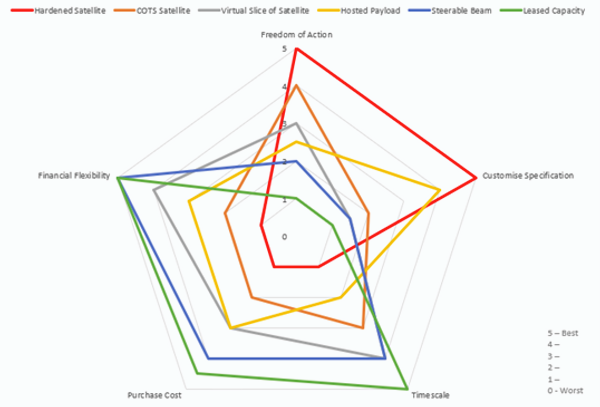Leveraging commercial capability to deliver assured satcom for UK Defence

John O'Connor
The MOD’s future MILSATCOM programme will deliver high-grade beyond line-of-sight communications capability to support the UK’s future military and security operations and wider governmental interests globally. Viasat understands that it will provide robust, survivable coverage in X- and mil-Ka-bands, delivering the minimum required assured connectivity within the UK interest “Core Region” defined by MOD. It may also extend coverage into the APAC region, with further coverage and capacity being provided through commercial partners and allies.
In an ideal world, MOD budgets would allow all, or almost all, operational risk to be bought out by procuring a future fleet of MILSATCOM to the highest bespoke specification and in sufficient numbers to provide both global coverage and resiliency in depth. Inevitably, difficult trade-offs become unavoidable when confronted with the challenge of balancing investment across a broad range of competing, vital capabilities.
The commercial space sector’s innovative capabilities, scalable production and rapid technology refresh rates provide pathways to improve acquisition agility and at the same time to enhance the resilience of national security space architectures complementary to a core of government-specified and owned hardened MILSATs. MOD architectures can benefit from making commercial solutions and services integral and not just supplementary to national security space architectures.
There is a wide spectrum of commercial options open to the MOD that might be leveraged, whether leased or bought, that could augment a sovereign core MOD owned MILSATCOM capability. These options are available at differing timescales and price points. In order to simplify and look at this at a high level, Viasat has identified a small number of key examples to illustrate that range. Each of these examples is compared against the conventional Skynet approach of procurement of a bespoke fully hardened satellite built to a detailed set of ‘exquisite’ requirements.
The examples used to illustrate the trade space against the baseline bespoke MILSAT are:
- Commercial off-the-shelf Satellite acquisition
- Leasing a ‘Virtual Slice’, utilising large, dedicated parts of a commercial payload
- Hosted Payload acquisition, in which MOD retains full control over the payload but transfers the bus build and operation to the operator
- Leasing a Steerable beam with independent control
- Leased Capacity
Comparing each of these options with the procurement of a bespoke, hardened military satellite, as shown in Figure 1, illustrates the differing trade-offs of each approach. We also see how, within a restricted budget, this core capability could be augmented by commercial options which deliver an optimised network in shorter time frames and with greater flexibility than through procurement of additional hardened satellites.
Procuring a COTS satellite or payload would reduce the lead-time for operational capability. In broad terms, the less customisation or ‘bespoking’ of capability from the existing commercial design, the sooner it can be delivered and the lower the cost. There is also scope, however, through early MOD engagement, to incorporate specific MOD requirements in the design beyond those normally expected in a COTS satellite and maintain a good balance between delivery schedule and customisation.
Hosted payloads, ‘virtual satellite slice’ and “confidential commanding” are all ways of allowing the MOD a high degree of autonomy, freedom of action and OPSEC by enabling it to command its payload through encrypted links veiled from the bus operator. Although the degree of autonomy and freedom of action would not be the equal of a bespoke, wholly owned MILSATCOM system, it would be fielded at a much lower cost and much faster than a bespoke system and offer a significant increase in security compared with direct use of commercial systems.

Figure 1: A trade-off comparison of commercial capabilities relative to a bespoke hardened satellite
Diversification of the future Skynet fleet to include carefully selected commercial capabilities of these example types brings additional advantages and should not be seen as a ‘compromised capability’. As captured in the US DoD Commercial Space Integration Strategy, “integration [of commercial capabilities] will help maintain our technological edge, deny adversaries the benefits of attacks against national security space systems, and contribute to a safe, secure, stable, and sustainable space domain”. Diversification also brings multiple layers of resilience of design, of components, form and function, physical location.
The commercial options under consideration may also make kinetic, EW or cyber targeting of a commercial asset utilised by non-combatant international partners a risky proposition for an adversary in terms of global perception; but it might be unwise to rely upon this chance without ensuring significant levels of redundancy. Both Russia and China have demonstrated their ability to manoeuvre to inspect and collect intel and, potentially to jam, spoof or physically intercept an adversaries’ satellite. Leveraging multiple commercial and allied capabilities, across multiple networks would allow ‘network manoeuvring’ to reduce the operational risk from such adversary actions. Industry now needs to collaborate to make network roaming easier, ideally as simple and seamless as moving a mobile phone from 5G to WiFi and back.
To paraphrase the MOD’s Integrated Procurement Model (IPM), in today’s rapidly changing threat environment, the MOD must be faster and more agile. It has therefore never been more important that the acquisition system is able to respond rapidly and adapt to changing circumstances. The IPM recognises that waiting for a 100% exquisite capability solution risks being too late and argues for a new alliance with industry that empowers and incentivises industrial innovation. Innovative use of commercial systems to augment and increase the resilience of core defence systems is an important approach to achieving this.





